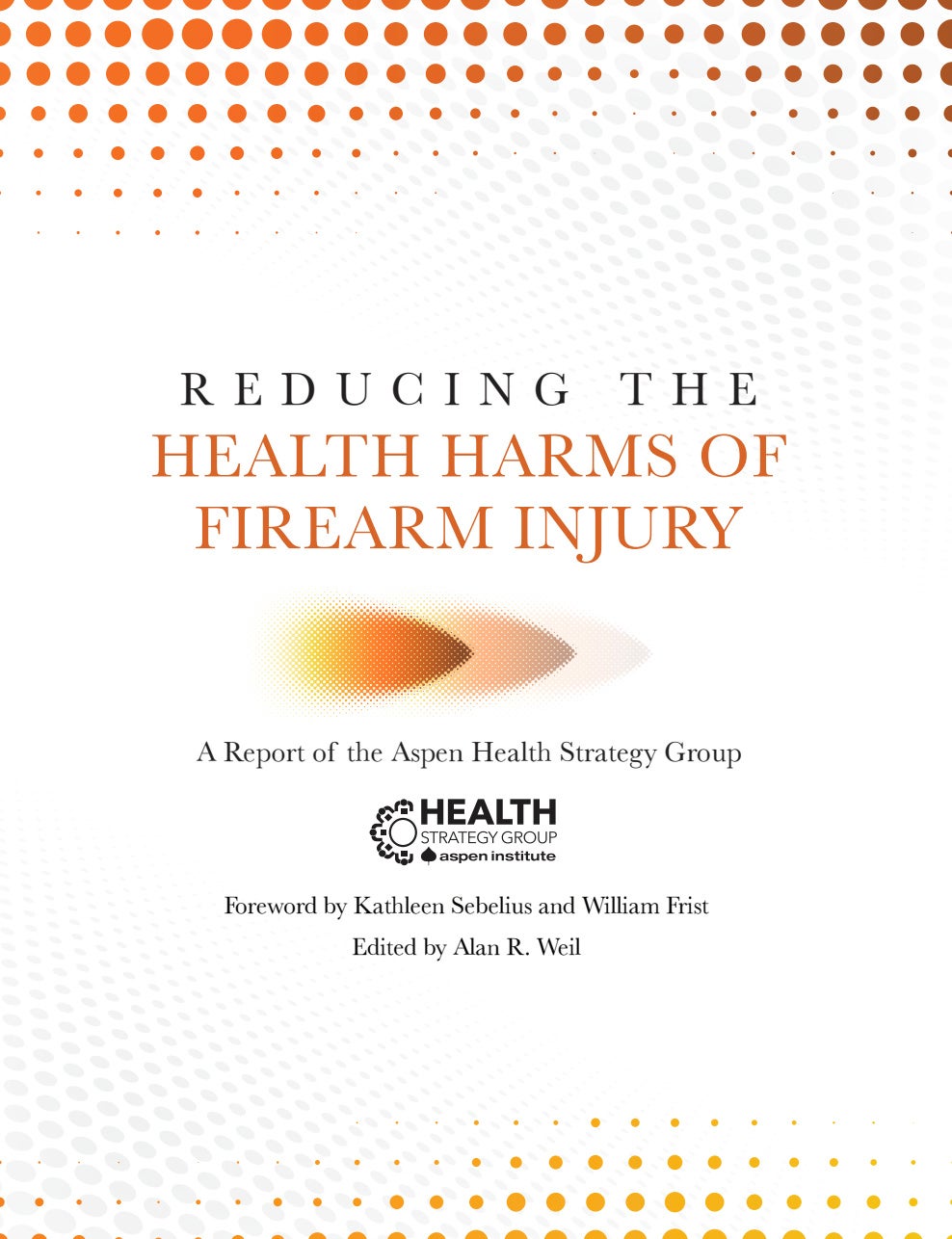The COVID-19 pandemic is forcing us to rethink how we connect with our neighbors, our workplaces, even our doctor’s offices. But for many public health leaders, these are not new challenges.
The practitioners serving underfunded and ignored groups, like people experiencing homelessness or poverty, have found ways to clear obstacles and build healthy communities, without the benefit of institutions that we take for granted. Their purpose is to build a healthy community characterized not only by the absence of disease but by attributes that promote well-being and enable a good quality of life.
The academic term for this is “social determinants of health,” or the social and environmental factors that impact our health like education, employment, food security, housing, gender, race, and disability. These social determinants matter to all of us—perhaps now more than ever—and we have a lot to learn from the leaders at the forefront of this work.
We spoke with the 2020 Aspen Healthy Community Fellows, experts on the social determinants of health, on the new challenges they’re seeing on the ground and solutions being made from the frontlines of fighting the coronavirus across the United States.

How does one wash hands without running water?
The saying “water is life” has never had so much meaning. Emma Robbins works with her community on the Navajo Nation to secure access to safe drinking water through her organization, DigDeep and the Navajo Water Project. Now, water may be an even more critical issue because many people within the community have never had running water.
How does one wash hands without running water? “Reusing water isn’t an effective way to wash your hands,” says Robbins, adding that the “20-second rule” isn’t really an option without warm running water. More than 2 million people in the US don’t have access to running water.
The organization has also had to pause installations of off-grid water systems to avoid entering families’ homes, oftentimes elders and the Navajo Water Project staff. But they’re still able to provide essential services, like water deliveries to the 270 homes that have received water systems, ensuring those community members who do have access to hot and cold water, will continue to do so.
Once the virus breaks, The Navajo Water Project’s next big phase will be piloting and installing septic systems in homes on the reservation; it’s their hope this will help stop the spread of the virus and (and other health issues) moving forward.
Rural America faces unique challenges
While rural Americans are the trailblazers of social distancing, the risks of an outbreak in a country town are enormous. So says Melissa Bosworth, the Executive Director of Eastern Plains Healthcare Consortium, a network of hospitals providing care to the rural communities on the Eastern Plains of Colorado. If you think the numbers for bed shortages in major US cities are bad, think about the eastern plains, where many hospitals only have 5 to 10 beds total.
Rural communities also tend to have large populations of the residents over the age of 65, so if an outbreak does happen, those beds will be filled quickly. The hospital that Bosworth is working at currently has no available beds, and huge gaps in their workforce to boot. This workforce issue exists across the board in rural America; while one-fifth of the nation’s population lives in a rural area, only 10 percent of the country’s primary physicians actually live there.
Internet access will also be a problem to tackle; only 63 percent of rural Americans have broadband internet. This makes other needs, like telemedicine and updates from their local health department, particularly challenging. Without access to those services and a shortage of healthcare providers, it will leave millions misinformed, and even more susceptible to illness.
When “shelter in place” isn’t an option for everyone
Mirtha Santana, the Vice President of Empowerment at Riseboro Community Partnership, supports homeless and low-income communities in Brooklyn, so is tackling unique obstacles. Between ensuring their children won’t go hungry during school closures, and finding ways to connect with clients virtually, there’s a lot of adjustments happening on the ground.
Evictions have been indefinitely suspended in New York because of coronavirus, but their clients are still suffering—there are still thousands adjusting to no longer having a home in the middle of a pandemic, requiring an extra layer of emotional support. “The poorest people will suffer the most,” she says. In addition to losing shelter, city guidelines requiring libraries, restaurants, and coffee shops to close ends up cutting off access for homeless people to wash their hands and use the bathroom.
While coronavirus has clearly left homeless families more vulnerable, Santana reminds us that the disease isn’t just targeting marginalized people. No one is exempt. “This is about all of us,” she says.
Domestic violence prevention is WhatsApp for immigrant women in Fresno County
Genoveva Islas, the founder and CEO of Cultiva La Salud, is creating a network of immigrant women using WhatsApp to build social connections, share resources and mobilize women to advocate for change in the communities where they live and the policies that affect them. These are all efforts focused on preventing domestic violence in Fresno County. This is especially vital when staff from the local domestic violence shelters struggle to meet the need for direct services and shelter space. The challenge is increasing given the mandate for individuals to work from home. This network offers one solution.
What’s better is in the short time the WhatsApp network has been up and running, it’s actually working. But while the numbers grow—a QR code is circulated to the members so they can loop their friends into the network—the real strength lies in the social bonds being created. Islas notes that it’s a powerful reminder of how dependent we are on one another. “In the time of coronavirus, our direct contact and connection to each other are seen as a weakness. However, connecting each other with purpose will always be a strength.”
As a longtime advocate fighting for health equity, Islas also couldn’t help pointing to the irony of the nation’s newfound laser focus on public health. “No one cares until it’s a time of sickness and death…that cannot be [the only time] we think it is important.”
Mitigating the risk of school lunch distribution
Erasma Monticciolo, Co-Founder and Executive Director of The Power of Two, uses science and community experience as a way to mitigate the negative impact of toxic stress in the lives of both children and their parents. And for the families that her organization supports, there are now multiple layers of stress for them to tackle from employment rights, remote learning, and food accessibility.
School lunch pickup has been a big hurdle. While lunches are being provided, few parents are going to pick them up in the interest of social distancing, as the pickup locations could easily draw crowds. Many would also be forced to bring their children along with them if there’s no one else in their home to watch them.
Monticciolo offers a simple yet brilliant solution: Why not use bus drivers to distribute the food along the bus route that all the families live on? “You can set up a schedule that way so exposure is minimized,” she adds. As access to school lunches have become a nationwide conversation around the pandemic, this could be an answer for the thousands of school districts across the country who are facing this challenge.
Erasma and her team have implemented virtual weekly check-ins with families to help them mitigate feelings of isolation and connect families to needed resources. The team has compiled a comprehensive COVID-19 resource guide and is shipping urgent baby essentials to families.
When home birth becomes the safer option
Adrienne Crawford is a certified nurse midwife at Community of Hope in Washington, DC, where some of the highest maternal and infant mortality rates exist in the US among African American communities.
While maternal health during a pandemic has become part of the national conversation, not much is being said about the obstetric practitioners navigating this crisis—and not much is being done to support them, either. The family doctors at Crawford’s center are solely treating COVID-19 patients, which means midwives are managing the rest. Recommendations are changing every day on how to treat patients, while the staff doesn’t have enough masks or tests to fully protect themselves.
Meanwhile, her patients are dramatically shifting decisions around their pregnancy. Many who had no interest in home birth are now seriously weighing that option (although there’s the uncertainty of whether there will be enough midwives to meet the demand). Other patients are terminating their pregnancies because they’re too scared of the health risks, or the risk of bringing a child into the world during an economic downturn. In a time span of four days, 1 in 5 of her patients terminated their planned pregnancies.
As both patients and practitioners have difficult decisions to make, being in the same space makes the health outcome of both groups intertwined. “How do we protect our frontline health workers during these times when they need to treat their patients?” Crawford says, adding, “There is a luxury to teleworking that frontline health workers don’t have.” The only thing they could do was create a sick ward—you walk down one hallway to treat the sick people, and down the next are the well ones.


